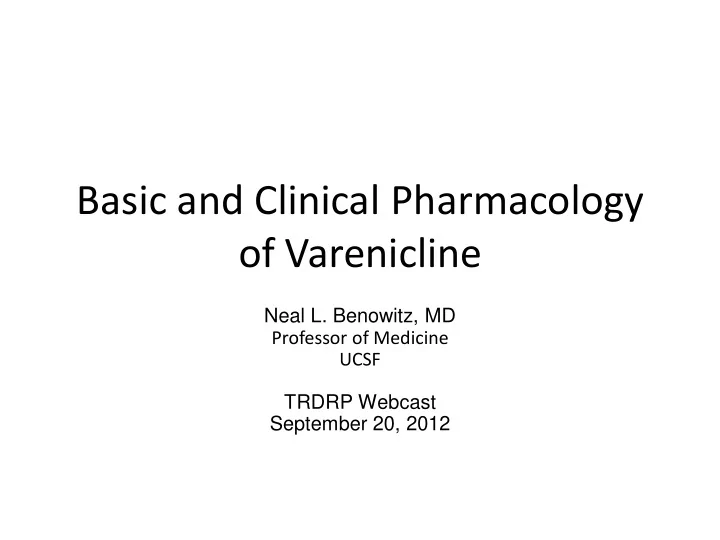

Basic and Clinical Pharmacology of Varenicline Neal L. Benowitz, MD Professor of Medicine UCSF TRDRP Webcast September 20, 2012
Disclosure Statement Dr. Benowitz has served on the Pfizer Varenicline Worldwide Advisory Board and on the scientific steering committee of Pfizer-supported varenicline clinical trials.
Objectives • Overview of neurobiology of nicotine addiction • Neurobiologic rationale for varenicline to treat tobacco dependence • Clinical pharmacology of varenicline • Possible mechanisms that might be involved in varenicline toxicity
Nicotine Addiction
Structure of Nicotinic ACh Receptors α acetylcholine pore z α α z z α α z z α α 1 x β β γ δ y y α β ion β α 1 x y neuronal type muscle type nicotinic receptors nicotinic receptor Picciotto M. Emerging neuronal nicotinic receptor targets . SRNT 9th Annual Meeting; February 2003; New Orleans, La.
DOPAMINE Pleasure, Appetite Suppression NOREPINEPHRINE Arousal, Appetite Suppression ACETYLCHOLINE Arousal, Cognitive Enhancement NICOTINE GLUTAMATE Learning, Memory Enhancement SEROTONIN Mood Modulation, Appetite Suppression BETA-ENDORPHIN Reduction of Anxiety and Tension GABA Reduction of Anxiety and Tensionn o Anxiety and Tension
Nicotinic Receptor Upregulation In Smokers
Tobacco Abstinence Symptom Clusters (Gross and Stitzer) • PSYCHOLOGICAL DISTRESS: Irritability, Anger, Impatience, Anxiety • DIFFICULTY CONCENTRATING: Cognitive and Performance Impairment • HUNGER AND EATING: Weight Gain • TOBACCO CRAVING • HEDONIC DYSREGULATION
Basic Pharmacology of Varenicline
Receptor Pharmacology • Potent partial agonist at α 4 β 2* and α 6 β 2* receptors • Activates nAChRs to ameliorate craving and withdrawal (50% of nicotine effect) • Antagonizes nAChRs to reduce rewarding effects of nicotine • May also desensitize nAChRs resulting in virtual full antagonism
Rationale for α 4 β 2 nAChR Partial Agonists Smoking No Smoking Smoking No Partial Ag Partial Ag + Partial Ag Nicotine Nicotine Part Ag Part Ag α 4 β 2 nAChR Antagonist Agonist Partial Agonist 50% Response 100% 50% Potential to block Potential to relieve reinforcing effects craving and withdrawal when smoking when quitting Dual action of a partial agonist
Nicotine, Varenicline and Brain Dopamine Release
Varenicline Actions on Other Receptors α7 homomeric – full agonist α3β4 – weak agonist 5-HT 3 (serotonin) – full agonist
Varenicline Binding Affinity to Nicotinic Receptors nACHR Ki or IC50 (nM) α4β2 0.4 α3β4 86 α7 125 α6 * 111
Clinical Pharmacology of Varenicline
Pharmacokinetics • Half-life ~ 24 hours • Cmax within 4 hours • Steady State reached after 4 days • No effect of food on concentrations • 93% of recovered drug in urine unchanged, 99% renal clearance • No inhibition of P450 enzymes
Varenicline effects during cigarette abstinence Brandon, Psychopharm 2011
Varenicline antagonizes nicotine-induced high Sofuoglu, Psychopharm 2009
7 -Day Point-Prevalence of Abstinence: Open-Label Treatment Phase 64.1 70 60 Varenicline 12 Weeks Open-label 50 Responders (%) 40 30 20 10 0 Week 0 1 2 3 4 5 6 7 8 9 10 11 12
Varenicline Pharmacology & Safety Concerns
Varenicline Safety Issue Most common side effects • Nausea (40%) • Abnormal dreams (23%) • Insomnia (19%) 10% discontinue treatment due to adverse drug effect
Varenicline and Nausea • May involve both central and peripheral mechanisms • Afferent stimulation in GI tract: 5-HT 3 and /or α3β4 receptors • Central: activation of α3β4 receptors • Tolerance usually develops
Varenicline Psychiatric and Neurological Safety Concerns Reports of agitation, violent behavior, depressed mood, suicidal ideation and behavior, worsening of pre-existing psychiatric illness, seizures.
Possible Neuropsychiatric Toxicity Mechanisms • Functional down regulation of α7 nAChR-schizophrenia • Presistent activation of α 4 β 2 – depression • Activation of α3β 4-anxiety
Varenicline Cardiovascular Concerns Reports of myocardial infarction, heart rhythm disturbances, sudden loss of consciousness
FDA Drug Safety Communication Chantix (varenicline) July 22, 2011 “Chantix may be associated with a small increased risk of certain CV events in patients who have CV disease…benefits should be weighed against potential risks in smokers with CV disease.”
OXIDANT CHEMICALS PARTICULATES NICOTINE CARBON OTHER COMBUSTION MONOXIDE PRODUCTS Sympathetic nervous system Inflammation Reduced activation Oxygen Availability Platelet Endothelial Increased heart rate Activation / dysfunction Coronary Increased blood pressure Thrombosis Vasoconstriction Increased myocardial contractility Increased Myocardial Reduced Myocardial Oxygen Demand Oxygen Supply Myocardial Ischemia Myocardial Infarction Sudden Death
Varenicline Cardiovascular Pharmacology • Α3β4 receptors in peripheral ganglia - release catecholamines, activate platelets. • α3β4 and α7 - may influence heart rate, blood pressure homeostasis. • Varenicline levels predicted to be too low to activate α3β4 and α7 nAChRs • No adverse CV effects in preclinical animal studies
Varenicline antagonizes nicotine-induced increase in heart rate Sofuoglu, Psychopharm 2009
Conclusions • Varenicline is a partial agonist that is highly but not entirely specific for α 4 β 2 nicotinic receptors. • Nausea is likely mediated by stimulation in GI tract of 5-HT 3 and α3β 4 receptors.
Conclusions (cont.) • Neuropsychiatric side effects speculated to be mediated by actions on α7, α 4 β 2 and/or α3β 4 receptors, but evidence is inconclusive. • Cardiovascular side effects speculated to be mediated by actions on α3β 4 and/or α7 receptors, but no evidence to support CV effects in experimental animal or human studies.
Recommend
More recommend